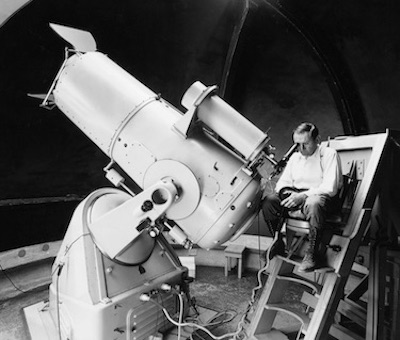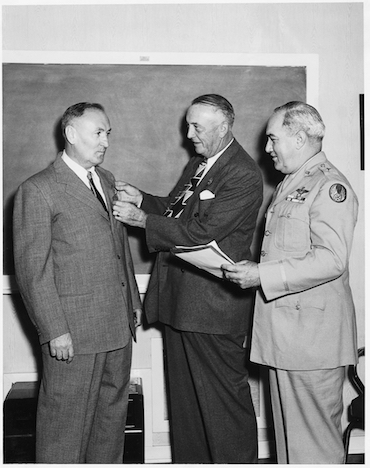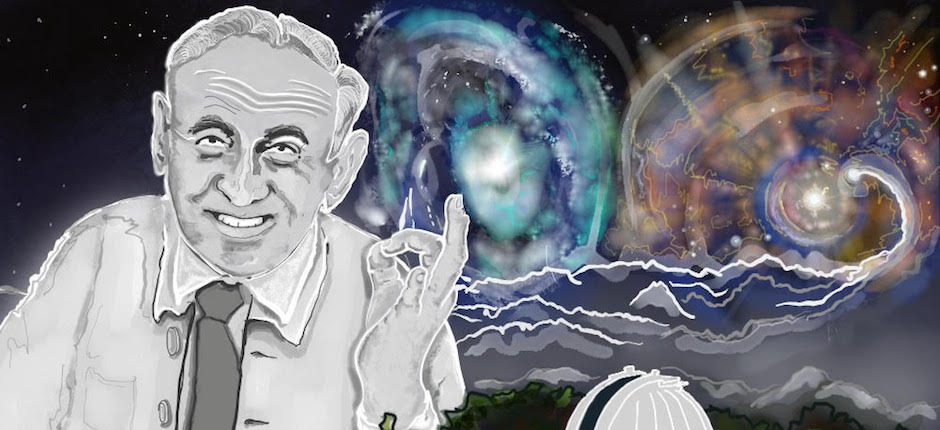When the young physicist Fritz Zwicky arrived in America in 1925, the universe was a tidy place. Some educated people still believed the Sun was at the center of everything and that our little neighborhood in space was everything there was.
In just a few years’ time, Zwicky, a combustible émigré from Switzerland whose feuds were as legendary as his insights, helped upend it all, by founding the field of supernova research and predicting the existence of neutron stars and dark matter. When he was finished, the once-staid field of astrophysics would never be the same. Neither would his adopted homeland. Zwicky’s ornery and freethinking nature helped lead American science and American power into a 20th-century golden age.
If it seems surprising someone so central to both scientific and national research is not a household name, that is partly due to Zwicky’s personality. To him, opposition was not something to be feared, but proof he was on the right track. Fighting accepted wisdom underpinned everything he accomplished in his working life, bringing him both honor and infamy. It was what lay behind his prediction of dark matter, the scaffolding on which the stars and galaxies are hung like ornaments on a Christmas tree. It was critical to his researches in jet propulsion and rocket fuels during and after World War II, which helped transform rockets—toys of backyard dabblers—into ballistic missiles and moon-bound spacecraft.
But while Zwicky’s fiercely independent nature propelled his research, which enabled the United States to dominate the postwar rocket industry, it was also responsible for his ultimate shaming at the hands of the country where he lived: For all of his contributions to U.S. science, he could never bring himself to become an American citizen. The same ingredients that fueled Zwicky’s scientific success also proved to be his undoing.
Fritz Zwicky was born on February 14, 1898, in Varna, Bulgaria, where his father, Fridolin, had moved to from Switzerland in search of business opportunities. (Though he was born in Bulgaria, anyone who called Zwicky a Bulgarian earned a blistering response; he considered himself a product of Switzerland, even though he sometimes referred to his countrymen, with typical hyperbolic pique, as “the stupidest people on Earth.”)
While Fridolin Zwicky hoped his son would take over the family businesses, including a factory that manufactured lead shot for hunters, his oldest boy showed talent for math and science. “[M]y father wrote me that in his opinion my brother was the real crook … and I should go into engineering or as a scientist,” Zwicky told an interviewer, many years later.
In October 1916, Zwicky enrolled at the Swiss Federal Institute of Technology, one of the elite engineering and science institutions in Europe, and Albert Einstein’s alma mater. After graduating from the institute in 1922, he began a career as a lecturer in physics there. Soon after, the Rockefeller Foundation offered him a two-year fellowship in America. Asked where in the U.S. he would like to go, Zwicky, a skilled climber of his native Alps, replied, “somewhere where there are mountains.”
He ended up at Caltech, in Pasadena, just 45 miles from Mount Wilson, where some of the greatest astronomers of the 20th century sat at the controls of the world’s largest telescope, the 100-inch Hooker, studying the life cycles of stars. Edwin Hubble, Harlow Shapley and others were making discoveries that proved that the Milky Way was just one of billions of galaxies, and that everything in the universe was on a headlong race to oblivion.

Zwicky at the eyepiece of Mt. Palomar’s 18-inch Schmidt telescope, which he helped build. The picture was taken in the summer of 1937, as Zwicky was “beating the tar” out of the sky searching for supernovae. Courtesy of the Fritz Zwicky Foundation.
Zwicky began his fellowship studying the structure of crystals. His early letters home revealed his anxiety about the competitive atmosphere at Caltech. “In America you are expected to produce something new every day,” he wrote to a friend. Still, Zwicky was drawn to the revolutionary work being done at Mount Wilson, and he soon found an ally in the German astronomer, Walter Baade. In 1933, the two produced a brief, five-page paper that the Nobel Prize winner Kip Thorne calls “one of the most prescient papers in the history of science.” “Cosmic Rays from Super-Novae” theorized that after some giant, older stars explode—becoming supernovae that send the building blocks of new stars, as well as of life on Earth, out into the cosmos—they shrink down into fantastically compact bodies, smaller than the size of Manhattan, made only of neutrons.
The idea outraged the physics community. The neutron had only been discovered the previous year, yet an outsider who was not even a trained astronomer was invoking processes and powers never dreamed of. But Zwicky and Baade were onto something very important. Their theory essentially marked the birth of high-energy astrophysics, relevant to everything from pulsars and quasars to supermassive black holes. It’s because of Zwicky and Baade that astrophysicists began to realize the importance of explosion/implosion events in space.
In another paper that same year, Zwicky made a remarkable suggestion about the so-called Coma Cluster of Galaxies. Calculating the total mass of the observable bodies in the cluster and their various velocities, he concluded that the density of the Coma system would have to be hundreds of times larger than it appeared in order to have enough gravity to keep the galaxies from flying apart. “If this would be confirmed we would get the surprising result that dark matter is present in much greater amount than luminous matter,” Zwicky wrote. This finding, he added, “harbors a problem that is not yet understood.”
Eight decades later, dark matter still isn’t understood—though scientists today, at least, agree with Zwicky’s notion that it must exist. After a 1933 conference where he revealed his ideas, Zwicky wrote a Swiss friend that “if the indignation of the foreign physicists takes on the same dimensions as those of the local ones, then we will have to fear for our lives. When I presented the new theory here in a seminar there was such an uproar that some of the more conservative gentlemen nearly died of heart attacks.”
Zwicky’s achievements continued during World War II. As director of research for a little rocket company called Aerojet, Zwicky supervised a staff of 300 chemists, engineers, and draftsmen working on small jato (jet-assisted take-off) rockets that enabled heavily laden planes to launch more quickly from aircraft carriers. In 1949, Zwicky became the first foreigner to win the Medal of Freedom, the highest U.S. civilian honor, in recognition of his work on jet propulsion and for debriefing Germany’s rocket scientists, including Wernher von Braun, after the war in Europe ended.

Undersecretary of the Navy Dan A. Kimball, accompanied by U.S. Air Force General Thomas C. Chapman, award the Presidential Medal of Freedom to Zwicky in September, 1949. Courtesy of the Fritz Zwicky Foundation.
Zwicky’s discoveries also laid the groundwork for the post-war U.S. rocket industry and the Space Race. The giant Saturn V rocket that took astronauts to the moon grew out of the little jet packs Zwicky and Aerojet developed for the military during the 1940s.
A tireless advocate of space research, in 1957, shortly after the Russians shot Sputnik into Earth orbit, Zwicky traveled to Alamogordo, New Mexico, and launched a German V-2 rocket containing small aluminum balls into the upper atmosphere, where the balls were then shot away from Earth orbit. For the rest of his life, Zwicky contended that his projectiles, which he called Artificial Planet Zero, were the first space launch to counter Russia’s Sputnik—not America’s Explorer 1 satellite, shot into orbit in 1958.
Zwicky’s achievements, and his often-stated belief that science held the solution for all the nasty problems that humankind had been afflicted by for ages, transformed him into a scientific—sometimes verging on pseudo-scientific—celebrity. Journalists sought his opinion on everything from Cold War politics to the existence of God. Unlike most scientists, who were suspicious of the public spotlight, Zwicky embraced it, touring widely and giving colorful speeches about the amazing new world that was just about to dawn. He wrote a German-language book, Every Man a Genius, laying out his philosophy that every person was capable of amazing things if they adopted his thinking process, which he called “Morphology.” One of a number of utopian philosophies to emerge around the mid-century, like Objectivism and Scientology, Morphology argued that every problem must be confronted with a completely open mind, considering every possible solution, no matter how seemingly absurd.
With Zwicky, however, every amazing achievement was accompanied by an equally stunning amount of discord and controversy. His fruitful partnership with Baade collapsed in rageful recriminations after Zwicky called Baade a Nazi. The U.S. government had initially classified Baade as an enemy alien during the war, but that was beside the point to Baade’s many friends in the astronomical community, who began distancing themselves from Zwicky.
Zwicky himself fell under suspicion in the McCarthy era for refusing to become an American citizen. He gave a variety of reasons, including that he might want to run for president of Switzerland one day. He also said he thought naturalized citizens were second class because their citizenship could be revoked under certain conditions. It went without saying that second class was a status the prideful Zwicky would not accept.
A vocal critic of the Soviet Union, Zwicky held a top-secret clearance that allowed him to work on vital defense projects after the war—such as using jet propulsion to power submarine torpedoes and developing an early warning system to track launching missiles from the Soviet Union. But when Senator Joseph McCarthy claimed Soviet influence had infiltrated the military, Zwicky’s resistance to become a U.S. citizen became problematic, and the Defense Department revoked his clearance. The act turned Zwicky into a cause célèbre in the media. “Zwicky, his head packed with vital secrets, could have no further contact with the classified projects that he has been supervising,” scolded TIME magazine.
Zwicky’s increasing isolation in academic and official circles only further stoked his penchant for blustery prognostications, which the press was all too eager to publicize. The solution to wars and privation? Drag pieces of the outer planets closer to the Sun, so that good people could escape evildoers like Hitler and Stalin. A next step in the arms race? The unlikely “Terrajet,” which would apply the principles of jet propulsion to a burrowing weapon. (The Russians were ten years ahead in the “Mole-Power Race,” Zwicky grumbled at a 1966 press conference.)
The final blow came in retirement, as Zwicky worked in a sub-basement office at Caltech to finish his monumental six-volume catalog of the galaxies, which scientists still consult in their research. His many battles with other scientists finally caught up with him, leading to his banishment from the great 200-inch telescope at Palomar Mountain. The observatory committee that allocated time on the telescope had made a new rule stating that retired professors could no longer have access to the instrument. James Gunn, the great Princeton astronomer who knew Zwicky, said it was widely assumed the rule was made specifically to get rid of Zwicky. Zwicky himself believed the same.
This was a crushing development to Zwicky, who had been the first working observer on the mountain in the 1930s and had at that point discovered more supernovae there than anyone in history.
His outbursts at physics colloquia had begun overshadowing his accomplishments. After nearly every lecturer’s presentation, he would rise and shout, “What’s new?” adding that he had discovered all that, decades ago.
Zwicky’s behavior inspired so much resentment that after his death in 1974 American science largely disparaged—or forgot—what he had done.
Like the great forces Zwicky chronicled, he distorted the orbits of everyone who came in contact with him, attracting and repelling in equal measure. Still, 80 years after his arrival on American shores, his impact is unmistakable. An iconoclast, rebel, challenger of accepted wisdom, Zwicky embodied fierce American individualism. And, though he never said so directly, his choice to remain in the U.S., rather than return to a pleasant, safe teaching position in Europe, proved that he knew it was only in America that his mixture of unbridled imagination and innovative experimentation could reach its full potential.
John Johnson, Jr. is a science writer who spent 22 years at the Los Angeles Times. He is the author of Zwicky: The Outcast Genius Who Unmasked the Universe.
Buy the Book
Skylight Books | Powell's Books | Amazon
PRIMARY EDITOR: Eryn Brown | SECONDARY EDITOR: Lisa Margonelli



Add a Comment